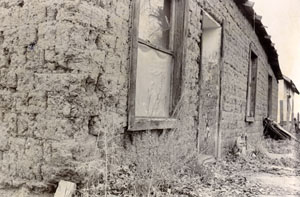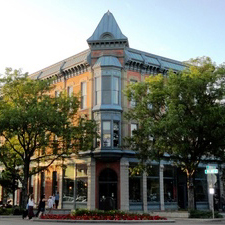Living in Spanish Colony (Alta Vista) and Building With Adobe
Reminiscence of Joe Herrera
April 14, 1975
Interviewer: Charlene Tresner

The Herrera's address was "Number One, Spanish Colony." It was Mr. and Mrs. Herrera's second home in the Fort Collins area. They originally had a home in Andersonville. Spanish Colony was the original name for the neighborhood now known as Alta Vista. Joe first came to this area in 1917 with his parents and siblings to work on a farm. He said that in the summertime they would work on the farms and in the winter they went to work in the lime quarry at Ingleside. German immigrants as well as those from Mexico worked the beet fields, Herrera recalls, and the two races got along well.
At the time of the interview, the Herreras had been married for 64 years. They had four children, but lost one. The three surviving children lived in Colorado Springs. They also raised Mrs. Herrera's niece from the time she was sixteen months old. Her parents of Trinidad, Colorado had died of the flu. Her married name was Valdez and she lived in Fort Collins on Park Street.
The Herreras were long-time members of Holy Family Church and remembered Father Fullana who built the school near the church. He was from Spain.
Mr. Herrera explained to the interviewer how to make adobe bricks, as they walked around the neighborhood trying to decide which homes were built of adobe. As adobe homes need to be covered with plaster or mud to protect the bricks from the elements, their original structure is not always apparent. Joe Herrera learned to make adobe bricks from his father when they were still in Mexico. To make adobe bricks, one must first find the right kind of mud. "Not very sandy and not very clayey. If too much sand is used, the bricks break easily." A neighbor, Mr. Romero, built his home from the clay in his own back yard.
Frames are built to hold the clay, sand, mud and straw mixture. These boxes can be eight by twelve inches or even sixteen inches in size, with a height of four inches. The bricks take only a day or so to dry, then the frames are removed, washed with water, and more bricks made. The bricks are piled up. Before you start building the house, it's best to have a concrete foundation. Then you lay the bricks, "one dobe here, one dobe here, one dobe there." A mud mixture joins the bricks. A wood floor would be laid, and the adobe plastered over. Then the roof was made of beams and a lumber overlay and finally, in Mexico, some dirt or sod finished the roof.
Adobe homes are warm in winter and cool in summer. Herrera thinks homes were first built in the Andersonville neighborhood in the 1920s, so that the workers could stay all summer. For years, most of the workers went back to New Mexico, Texas, or Mexico in the winter. He stressed that they needed to go "where there was work."
It was only in recent years that the homes in the neighborhood, originally called "Spanish Colony," received city gas after years of heating with coal. Although the Herreras and their neighbors didn't have to pay city taxes, they lacked a sewer system at the time of the interview. "They're working on getting the sewer out here. They've been saying that for quite a while and nothing happens," Mr. Herrera laughed. "Lots of talk."







